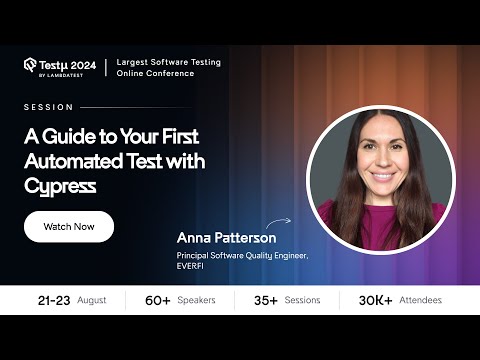In this session, Anna will guide you through overcoming common blocks in test automation, why Cypress is perfect for beginners, and provide a hands-on demo on writing your first automated test. Plus, get advanced tips to elevate your skills even further! 
 Register now and don’t miss out on this live session! Join here
Register now and don’t miss out on this live session! Join here 
Got questions? Drop them in the thread below! Let’s get automating! 

Hi there,
If you couldn’t catch the session live, don’t worry! You can watch the recording here:
Here are some of the Q&As from this session:
What are the key advantages of using Cypress over other automation testing tools for a beginner?
Anna: Cypress offers a user-friendly setup, real-time browser preview, and automatic waiting, which simplifies test writing and debugging. Its easy-to-understand syntax and rich documentation make it accessible for beginners. Cypress also provides a robust set of features out of the box, reducing the need for additional configuration.
How I can use Cypress for accessibility testing?
Anna: Use Cypress plugins like cypress-axe to integrate accessibility testing into your test suite. These plugins leverage tools like Axe to automatically check for common accessibility issues during tests. Write test cases that include accessibility checks alongside functional tests to ensure your application meets accessibility standards.
What strategies can be used to make Cypress tests more reliable and reduce flakiness?
Anna : Ensure tests are isolated and not dependent on external factors. Use Cypress commands like cy.wait() judiciously to handle asynchronous behavior. Mock network requests to stabilize tests. Regularly review and update tests to keep them aligned with the application’s current state and avoid relying on hard-coded values.
What are some common pitfalls and troubleshooting techniques when working with Cypress tests? How can I effectively debug failing tests and identify the root cause of issues?
Anna: Common pitfalls include flaky tests due to timing issues and improper use of Cypress commands. Troubleshoot by using Cypress’s built-in debugging tools, such as the command log and screenshots. Review test results and logs to identify patterns or errors. Use cy.debug() and cy.pause() to pause test execution and inspect the application state.
Now, let’s look into the few unanswered questions.
The Cypress xpath plugin is deprecated how can we use xpath in cypress now or using css are able write complex locators ?
What best practices should beginners follow when writing their first Cypress tests to ensure efficiency and maintainability?
What is Cypress, and what makes it a suitable tool for automated testing?
How can you write and organize your first test case using Cypress?
What are some key challenges to pivot to test automation in Cypress if you might have largely deep experience in manual testing?
Can you share examples or case studies where Cypress has been chosen over Playwright (or vice versa), and what were the key factors that influenced those decisions?
What are common challenges in Cypress?
How can you write and organize your first test case using Cypress?
Is there a sandbox-type environment in Cypress to help new users break in and get their feet wet with the features?
Can you elaborate on why Cypress is particularly suitable for beginners and how its features and community support contribute to a smoother learning curve?
What are the basic components of a Cypress test, and how do you structure your test files?
How do I start with Cypress for my first automated test? What are the essential steps and common pitfalls to avoid?
What are some tips for someone that is just breaking into the QA industry?
How can we think of the test pyramid as a cone or an ice cream but rather as a different approach to better testing ?
![]()
![]() Register now and don’t miss out on this live session! Join here
Register now and don’t miss out on this live session! Join here ![]()
![]()
![]()

